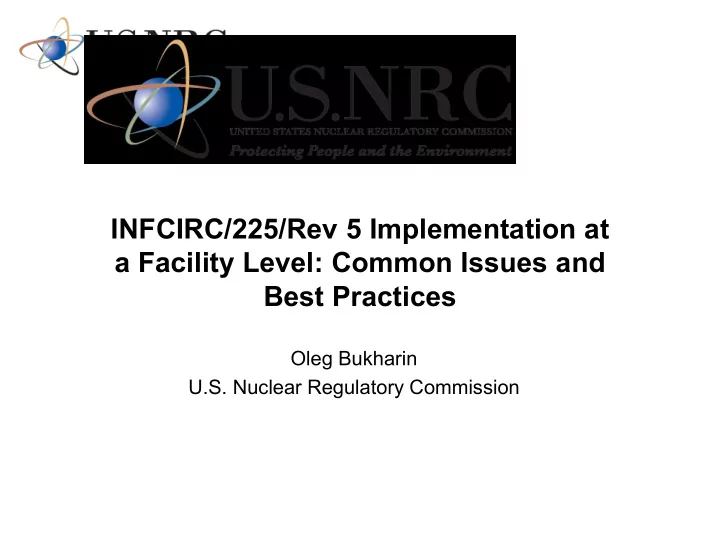

INFCIRC/225/Rev 5 Implementation at a Facility Level: Common Issues and Best Practices Oleg Bukharin U.S. Nuclear Regulatory Commission
Why INFCIRC/225 facility-level evaluations? • INFCIRC/225 is a recommendations document for nuclear physical protection – its significance is difficult to overstate!!! In addition, INFCIRC/225/Rev. 5 is used • in domestic regulations by some countries • as a physical protection standard in nuclear cooperation agreements • by IAEA in Project and Supply Agreements and during IPPAS missions • as an export licensing standard - e.g., U.S. NRC regulations state Physical security measures in recipient countries must provide protection at least comparable to the recommendations in the current version of IAEA publication … INFCIRC/225/Revision 5 …, which is incorporated by reference in [the NRC regulations]. Bottom line: INFCIRC/225 evaluations of facility’s physical protection measures may need to occur in certain cases
Challenges of INFCIRC/225 evaluations • Facility-specific considerations are important – Cultural and historical context – Facility operations and topography, nuclear material inventories, threat environment, etc. • There is more than one way for a physical protection system to achieve its objective – Security strengths in one area may compensate for less strong security features in other areas • General nature of recommendations in some cases 3
INFCIRC/225 evaluations: general points • Key question: do physical protection measures meet the intent of INFCIRC/225/Rev. 5? • Physical protection fundamentals always apply – Access authorization & control - detection/assessment - delay - response – Defense-in-depth • But is the system effective? – Use DBT and performance information – Consider an intelligent and disciplined adversary if DBT info not available • Interpretation of INFCIRC/225 is an art and a science – Evaluators should have deep practical understanding of physical protection fundamentals and experience in INFCIRC/225 interpretation – The operator’s input is important – There are common issues and best practices 4
Facility security boundaries • Q: Does the facility’s definition of security boundaries align with definitions in INFCIRC/225? INFCIRC/225 recommendations U.S.NRC licensees (examples) Cat II : Owner Controlled Area (OCA) = LAA Limited Access Area (LAA) SOCA - Security OCA – facilitates response strategy Protected Area (PA) Protected Area = PA Cat I: Cat II + Nuclear Island/ local security area – facilitates response strategy Inner Area (IA) Controlled Access Area = IA (for some materials) Strong room/ enclosure Material Access Area = IA NPP: Cat II + Vault = Strong Room Vital area Vital area = vital area • Best practice: identify security boundary equivalencies – Ensure the number of boundaries is consistent with INFCIRC/225 for the nuclear material and facility category – Ensure that each selected boundary provides for effective detection, assessment, delay, and access control 5
Entry and exit searches • Q: What does “subject to search” mean? • Best practice – Consider credible malicious activity scenarios – Conduct 100% entry search at high-risk Category I facilities and NPPs – Exit search programs should be more robust for materials that are attractive and that can be removed covertly – Random searches or alternative measures could be acceptable in certain cases – Conduct and document analysis, create procedures 6
Vehicle barriers systems (VBS) • Q: What is an effective VBS? EXAMPLE: 1993 vehicle intrusion at a US NPP – a chain-link fence is NOT an effective VBS Example of an effective VBS • Best practice – Install VBS to eliminate/control credible pathways – Ensure VBS is capable of stopping a DBT vehicle – Consider vehicle bomb attacks if appropriate 7
Secure communications • Q: What does “secure communications” mean? • Best practice – Not every situation requires the use of encrypted communications – Reliability and effectiveness of communications are critical – system redundancy and diversity are the key – Use of authentication protocols and code words can increase communications security 8
Response force • Issue: Complete response force information is not always available • Best practice – Evaluators should seek general understanding of response force arrangements and focus on scope and frequency of performance testing and site familiarization training » Conduct periodic exercises to test response timelines » Conduct force-on-force exercises with simulated combat at critical facilities – Ensure frequent communication checks between CAS and off-site response forces 9
Conclusions • INFCIRC/225 is a valuable evaluation tool • INFCIRC/225 evaluations should seek to determine whether physical protection measures meet the intent of the recommendations – physical protection fundamentals always apply • Effective interpretation of INFCIRC/225 is important • Reliable protection of nuclear materials and facilities is the goal 10
Recommend
More recommend